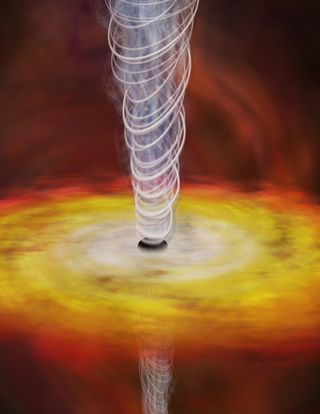Rare Flickering Black Hole Jet Challenges Theories

A close-up view of a rare, flickering black hole jet has scientist rethinking how these enormous eruptions form.
Black holes are mostly known for gobbling up everything that gets near them, including light. But there are also jets of matter rushing away from many black holes — like cosmic fire hoses. Two years ago, the MAGIC telescope, located in the Canary Islands, happened to catch a black hole jet doing something very rare: It was flickering.
Radiating from a black hole in a galaxy called IC 310, the jet was emitting bright flashes of gamma rays — the highest-energy light in the universe. The flashes would reach 10 to 100 times the normal brightness of the jet in a matter of minutes. The light show lasted just over three hours.
Switching a flashlight on and off doesn't take much effort, but at this cosmic scale the flickering would require a massive amount of energy, according to the authors of a new research paper that uses the data from the MAGIC-II observation. The best explanation scientists have given for how such flares might occur is called shock acceleration. But that would require a very large area to create those brilliant flashes, the researchers say, and there's no way it could make them as quickly. [Strangest Black Holes in the Universe]
"But we have found something very, very fast, and very, very small," said Dorit Eisenacher, a doctoral candidate at the University of Würzburg in Germany, and an author on the new paper.
The new research shows that the portion of the jet responsible for generating the flares is five times smaller than what shock acceleration would require.
In other words, say the researchers, the current theory doesn't cut it.
Get the Space.com Newsletter
Breaking space news, the latest updates on rocket launches, skywatching events and more!
"For most sources [the shock acceleration model] was working nicely. It looks like for IC 310 it does not work," said Julian Sitarek, an astrophysicist at the Institute for High Energy Physics (IFAE) near Barcelona, Spain, and an author on the new study.
The researchers have an alternative proposal. When a star dies and collapses in on itself, it may become a pulsar: an incredibly dense, rapidly spinning nugget. Pulsars emit two bright beams of light, not unlike black hole jets. As the pulsar spins, the beams sometimes flash toward earth, and so the pulsar looks like it is blinking on and off.
In 2011, another group of researchers proposed that a similar mechanism that drives pulsar beams could also generate flare events like the one seen in IC 310. Shock acceleration, as its name implies, would move particles with the physical force of a shock wave. Accelerating particles will radiate, so a sudden shockwave pushing particles up and out could also create gamma-ray flashes. Alternatively, particles are accelerated in pulsar beams by an electric field. This requires a much smaller area to get the particles moving.
"We tried a few other scenarios, but each of them had some problems," said Sitarek. "The pulsar theory is a plausible explanation for what we saw."
The details of how this mechanism might work in black holes will be difficult to sort out. Ideally, the team would like to have more data, from more black hole flares. But because the flaring events are short and unpredictable, it is extremely difficult to get telescope observations of them. For now, the researchers can only wait, but Sitarek is hopeful that black hole IC 310 has more to show them.
"With this source, every time we look at it we get some surprise," he said. "Next time we look at this, maybe we get even bigger surprises."
The new research is detailed in the Nov. 7 issue of the journal Science.
Follow Calla Cofield @callacofield.Follow us @Spacedotcom, Facebook and Google+. Original article on Space.com.
Join our Space Forums to keep talking space on the latest missions, night sky and more! And if you have a news tip, correction or comment, let us know at: community@space.com.

Calla Cofield joined Space.com's crew in October 2014. She enjoys writing about black holes, exploding stars, ripples in space-time, science in comic books, and all the mysteries of the cosmos. Prior to joining Space.com Calla worked as a freelance writer, with her work appearing in APS News, Symmetry magazine, Scientific American, Nature News, Physics World, and others. From 2010 to 2014 she was a producer for The Physics Central Podcast. Previously, Calla worked at the American Museum of Natural History in New York City (hands down the best office building ever) and SLAC National Accelerator Laboratory in California. Calla studied physics at the University of Massachusetts, Amherst and is originally from Sandy, Utah. In 2018, Calla left Space.com to join NASA's Jet Propulsion Laboratory media team where she oversees astronomy, physics, exoplanets and the Cold Atom Lab mission. She has been underground at three of the largest particle accelerators in the world and would really like to know what the heck dark matter is. Contact Calla via: E-Mail – Twitter
